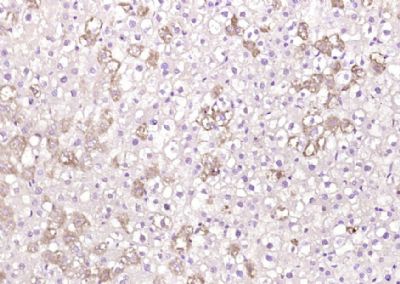产品货号 : mlR12501
英文名称 : ApoM
中文名称 : 载脂蛋白M抗体
别 名 : Apo M; Apo-M; Apolipoprotein M; ApoM; APOM_HUMAN; G3A; HSPC336; MGC22400; NG20; NG20 like protein; Protein G3a.
研究领域 : 肿瘤 细胞生物 新陈代谢
抗体来源 : Rabbit
克隆类型 : Polyclonal
交叉反应 : Human, Mouse, Rat, Dog, Pig, Cow, Horse, Sheep,
产品应用 : WB=1:500-2000 ELISA=1:500-1000 IHC-P=1:400-800 IHC-F=1:400-800 ICC=1:100-500 IF=1:100-500 (石蜡切片需做抗原修复)
not yet tested in other applications.
optimal dilutions/concentrations should be determined by the end user.
分 子 量 : 21kDa
细胞定位 : 分泌型蛋白
性 状 : Lyophilized or Liquid
浓 度 : 1mg/ml
免 疫 原 : KLH conjugated synthetic peptide derived from human ApoM/Apolipoprotein M:101-188/188
亚 型 : IgG
纯化方法 : affinity purified by Protein A
储 存 液 : 0.01M TBS(pH7.4) with 1% BSA, 0.03% Proclin300 and 50% Glycerol.
保存条件 : Store at -20 °C for one year. Avoid repeated freeze/thaw cycles. The lyophilized antibody is stable at room temperature for at least one month and for greater than a year when kept at -20°C. When reconstituted in sterile pH 7.4 0.01M PBS or diluent of antibody the antibody is stable for at least two weeks at 2-4 °C.
PubMed : PubMed
产品介绍 : Apolipoproteins are protein components of plasma lipoproteins. ApoM (Apolipoprotein M), also known as protein G3a, is a member of the Lipocalin family of proteins. ApoM is exclusively expressed in kidney tubular epithelial cells and liver hepatocytes. Mature ApoM retains its signal peptide, which acts as a hydrophobic anchor, and contains a structurally conserved eight stranded antiparallel ∫ barrel which binds retinol and retinoic acid. ApoM may play a key role in reverse cholesterol transport. It mainly associates with high density lipoprotein (HDL) and to a lesser extent with triglyceride-rich lipoprotein (TGRLP) and low-density lipoprotein (LDL). ApoM is important for the pre∫-HDL formation. Pre∫-HDL is an important acceptor of peripheral cellular cholesterol. The concentration of ApoM in plasma strongly correlates with total cholesterol. Low concentrations of ApoM in plasma is associated with diabetes.
Function:
Probably involved in lipid transport. Can bind sphingosine-1-phosphate, myristic acid, palmitic acid and stearic acid, retinol, all-trans-retinoic acid and 9-cis-retinoic acid.
Subcellular Location:
Secreted. Present in high density lipoprotein (HDL) and to a lesser extent in triglyceride-rich lipoproteins (TGRLP) and low density lipoproteins.
Tissue Specificity:
Plasma protein. Expressed in liver and kidney.
Similarity:
Belongs to the calycin superfamily. Lipocalin family. Highly divergent.
SWISS:
O95445
Gene ID:
55937
Important Note:
This product as supplied is intended for research use only, not for use in human, therapeutic or diagnostic applications.
产品图片












